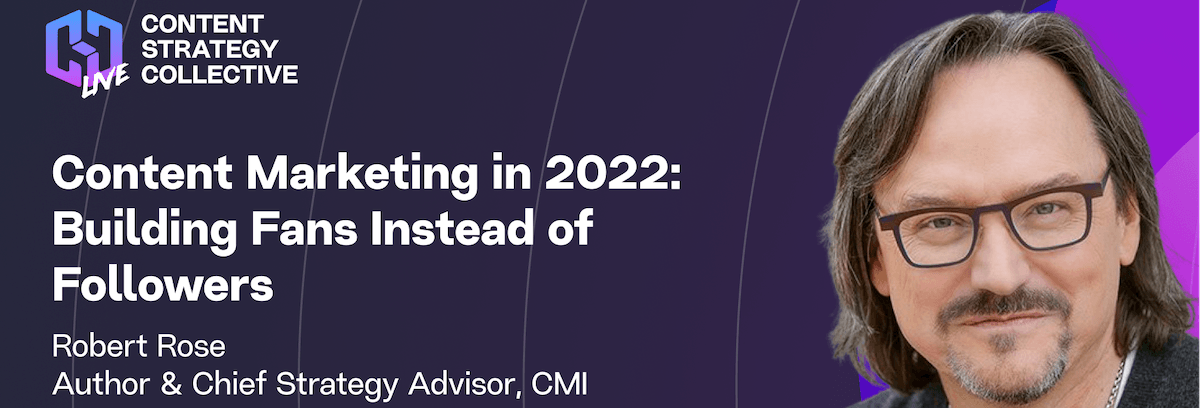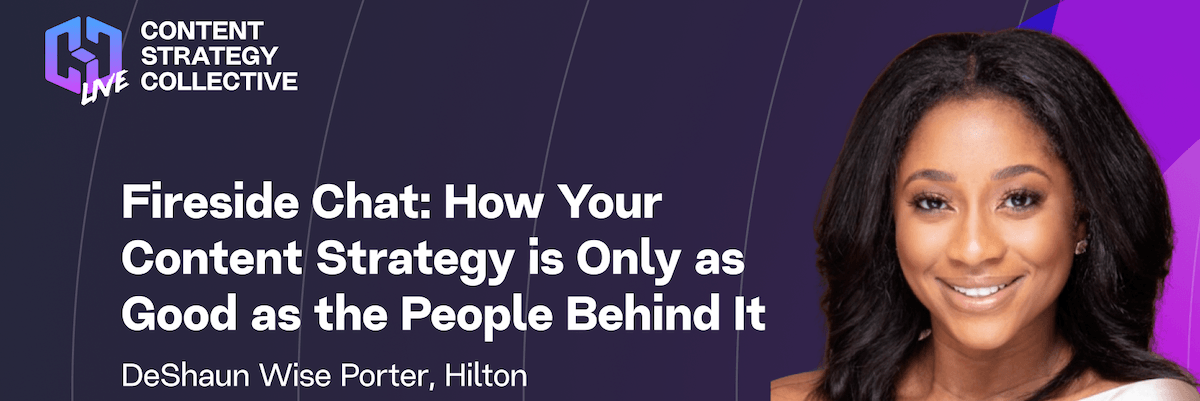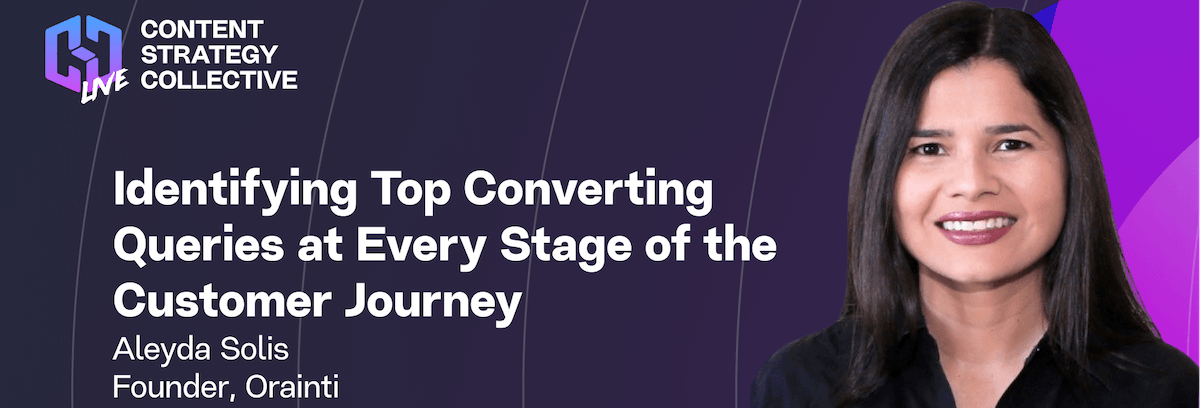CSC Live 2022 Takeaways
There was so much amazing knowledge and insight shared at CSC Live 2022 over the course of three days! Here are some takeaways from the nearly 20 hours of content. I’ll be the first one to admit, there’s a lot missing here. But if you’re looking to get a little taste of what you missed, this may help.
We’ve also put together this YouTube playlist of all the free sessions from each morning.
Robert Rose – Content Marketing In 2022: Building Fans Instead of Followers.

On June 7th, 2022 Robert Rose opened our three day event with his session, Content Marketing In 2022: Building Fans Instead of Followers. What’s the difference between a fan and a follower you ask? And how does that affect your strategy?
As Robert explains, “You can’t just settle bar bets with your content.” At one time, it was enough to just supply accurate information to answer the important questions your audience was asking. Becoming the FAQ of your industry was the ultimate goal in the eyes of many content marketers.
But it’s no longer enough.
Your content needs to hold the attention of your audience and engage with them in order to create a true fan. As a fan, they’re the one most likely to comment on your content, promote and evangelize it. And this needs to occur over the entire buyer journey.
The only way for this to effectively work is if content becomes an organizational strategy that empowers all members of an organization to create a holistic story. Once you get beyond siloed teams of people producing digital assets, you can transform content into a “business strategy that drives value for your business.”
Michael Brenner – 10 Steps To Optimize Your Content Marketing Program for ROI

“Content marketing is an asset with real value that grows over time.” That’s the conversation Michael Brenner says you should be having with marketing executives every day. Not only does the value grow, the financial return accelerates over time.
Here’s the thing.
Michael explains that his clients spend on average about $85,000 per month on paid advertising. That’s no small change.
But do you know what happens when they stop spending money on paid ads?
The results drop to zero.
Contrast that with his clients who spend on average $4,000 per month on content marketing, publishing twice a week. Michael’s company can demonstrate a $7 return for every dollar invested in their content program.
John Hall – How To Own Your Industry Through Aligning PR, Thought Leadership, and SEO

In this fireside chat with MarketMuse cofounder Jeff Coyle, John Hall discusses the value of digital public relations. John finds that, as long as your strategy is aligned with search, a natural approach to earned media placement tends to get rewarded by Google.
From his perspective, the best strategies are very natural and diversified. That runs counter to the approach of the typical SEO company that does placement. In that case they’re just focused on buying links.
While John’s approach is very natural, it’s also very strategic. Hey may determine that you need links from several different types of sources. That could be properties that have features, others that have lists, ones that are followed, others that are no-follow, etc.
PR used to be about getting placements. But, as John explains, the goal needs to shift to getting placements to help “increase our organic traffic, that results in industry leadership, which can be measured by organic growth, sales leads, things like that.”
DeShaun Wise Porter – Fireside Chat: How Your Content Strategy is Only as Good as the People Behind It

On the last day of the event, DeShaun Wise Porter of Hilton and MarketMuse CEO Charles Frydenborg had an engaging fireside chat about the importance of diversity, equity, and inclusion (DEI) in your content and SEO teams, and what leaders can do to create a more inclusive culture. Drawing from her extensive experience, including at Hilton, DeShaun explains that belonging means “having a space where you feel accepted, appreciated, and most importantly, that you feel seen.” She believes that creating that space absolutely requires “a foundation set by the leadership of the company.” To create that spirit of belonging, DeShaun stresses the importance of “accepting of all diverse backgrounds, accepting of the differences and actually taking a step forward in which to celebrate those differences.”
Aleyda Solis – Identifying Top Converting Queries at Every Stage of the Customer Journey

Aleyda Solis covers a lot of ground in her presentation on query identification. One thing she strongly suggests is to compare your own pages against the competition using software MarketMuse. Unlike the generic competition level that keyword tools provide, content optimization software allows you to compare topical coverage against your SERP competitors.
Although Aleyda didn’t mention this, MarketMuse is unique in offering Personalized Difficulty scores for all topics that a site covers. Unlike Keyword Difficulty, which indicates how hard it is for anyone to rank, Personalized Difficulty shows how hard it is for your site to rank.
Equally important is understanding what the stage of the customer journey someone is at when they’re searching. This will have a dramatic impact on the type of content and pages you create. If the content already exists, it may need to be optimized and even consolidated in order to effectively connect with your audience and rank.
Alyeda uses a great visual in her presentation comparing the search journey vs. content funnel. In it she shows the different stages of the journey along with search phrases, questions, and content types that match. For example, at the awareness stage guides and resource pages help searchers better understand their problem and move them to the next stage, consideration. At this level, categories, brands, and facet pages enable comparison and product evaluation culminating in a purchase on a product page, the last step in the funnel.
Johnathan Gandolf – The New B2B Marketing: Boring 2 Bingeable

Jonathan Gandolf believes “there’s a lot of work to be done to make B2B content as bingeable as B2C content.” He thinks that part of the problem may be that content marketers can be too polar in comparing B2B versus B2C.
Really, that should be irrelevant given that “we’re all consumers at the end of the day.” So the delineation of B2B and B2C doesn’t matter when it comes to creating enjoyable experiences. Sure, the B2B buying journey may be more complex and nuanced than B2C. “But if you’re not creating enjoyable experiences, how are you gonna inspire your prospects? And what are you doing to imitate those B2C marketing experiences that you so much enjoy?“
Amanda Milligan – Want to Earn Links at Scale? Try Newsworthy Content

Your product or service isn’t as interesting as you think it is. Don’t take it personally as this applies to everyone. Which is why Amanda Milligan encourages content marketers to zoom out and consider “the scope of your entire vertical, the arena that you play in.” Granted, at this level you’re appealing to a more general audience with tangential content. But you do want that group to include your target audience. In this way you can overlap things like your overall brand mission with newsworthy elements. As a result “you’re able to create the best kind of content you can for earning links.”
Maddy Osman – Writing for Humans and Robots: The New Rules of Content Style

When creating content for discovery in search it’s easy to overlook the human part. But as Maddy Osman likes to remind us, “robots can’t buy whatever it is you’re selling.” It’s a delicate balance to satisfy both search engines and people so that you show up where people are looking for you. However, you want to prioritize humans over everything else. As Maddy explains, “we are only trying to loop them (search engines) in a way that they can understand so that they can serve up your content to these humans that are empathetic, and that actually have bank accounts and they can buy things.” Never forget that search engine bots are simply a connection between searchers and your content.
Lilly Ray – Data-Driven Approach to Semantic SEO

In Lily Ray’s presentation on her data-driven approach to semantic SEO, she outlines how she uses MarketMuse in her daily workflow. At the page level, she uses the Optimize application for a topic with one single search intent, or what she calls “a refined scope of content.” She finds this to be “ideal for something like a supporting article.” She also uses it to “target a sub collection of terms within a larger cluster” pointing out that MarketMuse uses semantic analysis to create topic models as opposed to relying on correlation data.
Another way that Lily uses MarketMuse is when optimizing for multiple search intents. Typically found in pillar pages or those with multiple searches, in this case she avails herself of MarketMuse content briefs. According to Lily, SEOs would traditionally look for what they call secondary keywords but with semantic SEO the approach is slightly different. Here we’re looking at topics that are closely related to the main topic.
So different searchers may have different reasons to land on a specific page and thus receive different value. A comprehensive page may cover what something is, why it’s important, its benefits, and how to use it.
Instead of creating individual pages to match each intent, she creates sections on one page to meet specific intents. She relies on MarketMuse content briefs for this because we create individual topic models for each section, allowing her to it all those intents.
“So it sounds advanced, but luckily MarketMuse makes it really easy for us. The tool actually does a lot of the heavy lifting so we can leave it to our team to just implement the recommended optimizations.”
Kris Ruby – Web3 PR & Content Marketing: How to Prepare for Metaverse Digital Transformation

Kris Ruby believes that “the rise of decentralized content on blockchain platforms will substantially impact your content marketing strategy.” Exactly how that will play out is anyone’s guess. One concern she highlights is that entries on the blockchain “aren’t necessarily being searched by Google. Of course, that could change.”
Google is one big black box and web3 is still so young, which makes it hard to make any sort of predictions. As Kris points out, “is it indexed? We don’t know yet. It could be indexed, but we may be a long way away from seeing that happen. What does web 3 mean for the future of search if content on blockchain is not indexed? Well, that’s a problem for you and your rankings.”
Kris goes on to discuss a real world example where someone moved their entire marketing strategy on to different chains, resulting in a significant drop in traffic from important search terms. As she notes, this could be a short-term or long-term problem depending on whether or not things change and when. So tread carefully.
What you should do now
When you’re ready… here are 3 ways we can help you publish better content, faster:
- Book time with MarketMuse Schedule a live demo with one of our strategists to see how MarketMuse can help your team reach their content goals.
- If you’d like to learn how to create better content faster, visit our blog. It’s full of resources to help scale content.
- If you know another marketer who’d enjoy reading this page, share it with them via email, LinkedIn, Twitter, or Facebook.
Stephen leads the content strategy blog for MarketMuse, an AI-powered Content Intelligence and Strategy Platform. You can connect with him on social or his personal blog.